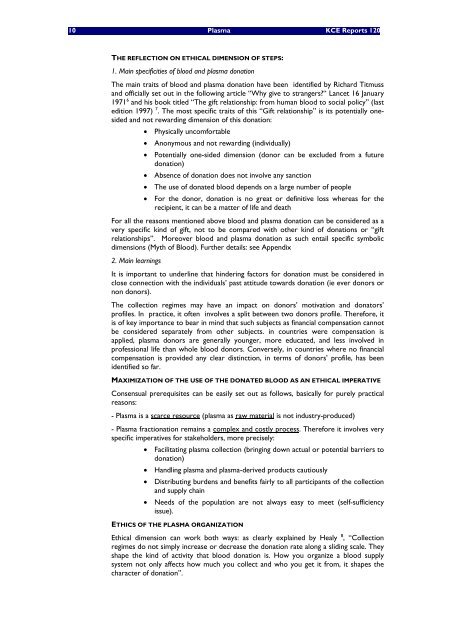The report is available in English with a Dutch summary - KCE
The report is available in English with a Dutch summary - KCE
The report is available in English with a Dutch summary - KCE
You also want an ePaper? Increase the reach of your titles
YUMPU automatically turns print PDFs into web optimized ePapers that Google loves.
10 Plasma <strong>KCE</strong> Reports 120<br />
THE REFLECTION ON ETHICAL DIMENSION OF STEPS:<br />
1. Ma<strong>in</strong> specificities of blood and plasma donation<br />
<strong>The</strong> ma<strong>in</strong> traits of blood and plasma donation have been identified by Richard Titmuss<br />
and officially set out <strong>in</strong> the follow<strong>in</strong>g article “Why give to strangers?“ Lancet 16 January<br />
1971 6 and h<strong>is</strong> book titled “<strong>The</strong> gift relationship: from human blood to social policy” (last<br />
edition 1997) 7 . <strong>The</strong> most specific traits of th<strong>is</strong> “Gift relationship” <strong>is</strong> its potentially onesided<br />
and not reward<strong>in</strong>g dimension of th<strong>is</strong> donation:<br />
• Physically uncomfortable<br />
• Anonymous and not reward<strong>in</strong>g (<strong>in</strong>dividually)<br />
• Potentially one-sided dimension (donor can be excluded from a future<br />
donation)<br />
• Absence of donation does not <strong>in</strong>volve any sanction<br />
• <strong>The</strong> use of donated blood depends on a large number of people<br />
• For the donor, donation <strong>is</strong> no great or def<strong>in</strong>itive loss whereas for the<br />
recipient, it can be a matter of life and death<br />
For all the reasons mentioned above blood and plasma donation can be considered as a<br />
very specific k<strong>in</strong>d of gift, not to be compared <strong>with</strong> other k<strong>in</strong>d of donations or “gift<br />
relationships”. Moreover blood and plasma donation as such entail specific symbolic<br />
dimensions (Myth of Blood). Further details: see Appendix<br />
2. Ma<strong>in</strong> learn<strong>in</strong>gs<br />
It <strong>is</strong> important to underl<strong>in</strong>e that h<strong>in</strong>der<strong>in</strong>g factors for donation must be considered <strong>in</strong><br />
close connection <strong>with</strong> the <strong>in</strong>dividuals’ past attitude towards donation (ie ever donors or<br />
non donors).<br />
<strong>The</strong> collection regimes may have an impact on donors’ motivation and donators’<br />
profiles. In practice, it often <strong>in</strong>volves a split between two donors profile. <strong>The</strong>refore, it<br />
<strong>is</strong> of key importance to bear <strong>in</strong> m<strong>in</strong>d that such subjects as f<strong>in</strong>ancial compensation cannot<br />
be considered separately from other subjects. <strong>in</strong> countries were compensation <strong>is</strong><br />
applied, plasma donors are generally younger, more educated, and less <strong>in</strong>volved <strong>in</strong><br />
professional life than whole blood donors. Conversely, <strong>in</strong> countries where no f<strong>in</strong>ancial<br />
compensation <strong>is</strong> provided any clear d<strong>is</strong>t<strong>in</strong>ction, <strong>in</strong> terms of donors’ profile, has been<br />
identified so far.<br />
MAXIMIZATION OF THE USE OF THE DONATED BLOOD AS AN ETHICAL IMPERATIVE<br />
Consensual prerequ<strong>is</strong>ites can be easily set out as follows, basically for purely practical<br />
reasons:<br />
- Plasma <strong>is</strong> a scarce resource (plasma as raw material <strong>is</strong> not <strong>in</strong>dustry-produced)<br />
- Plasma fractionation rema<strong>in</strong>s a complex and costly process. <strong>The</strong>refore it <strong>in</strong>volves very<br />
specific imperatives for stakeholders, more prec<strong>is</strong>ely:<br />
• Facilitat<strong>in</strong>g plasma collection (br<strong>in</strong>g<strong>in</strong>g down actual or potential barriers to<br />
donation)<br />
• Handl<strong>in</strong>g plasma and plasma-derived products cautiously<br />
• D<strong>is</strong>tribut<strong>in</strong>g burdens and benefits fairly to all participants of the collection<br />
and supply cha<strong>in</strong><br />
• Needs of the population are not always easy to meet (self-sufficiency<br />
<strong>is</strong>sue).<br />
ETHICS OF THE PLASMA ORGANIZATION<br />
Ethical dimension can work both ways: as clearly expla<strong>in</strong>ed by Healy 8 , “Collection<br />
regimes do not simply <strong>in</strong>crease or decrease the donation rate along a slid<strong>in</strong>g scale. <strong>The</strong>y<br />
shape the k<strong>in</strong>d of activity that blood donation <strong>is</strong>. How you organize a blood supply<br />
system not only affects how much you collect and who you get it from, it shapes the<br />
character of donation”.

















